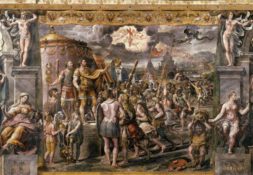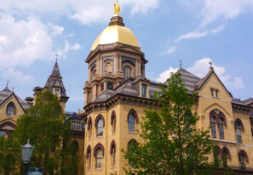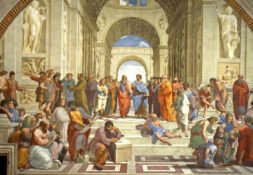I spent this past summer in the beauty business. No, I did not toil alongside cutting-edge stylists at a glistening hair salon or help to handcraft a swanky pair of exceptional leather shoes, despite the fact that I resided in trendy Italy. Rather, I encountered something vastly more beautiful in the city of Rome—Beauty itself.
An ordinary day for me involved assisting tours and pilgrimage groups through popular sites such as the Vatican Museums and St. Peter’s Basilica. Essentially, I was the Miss Ungermeyer to a numerous amount of Lizzies and Gordos for the summer. (If you do not get the reference, I am heartbroken for your childhood.)
After accumulating what seemed to be my thousandth ticket to the Vatican Museums, I belatedly asked myself why tourists, such as those I worked with, continuously travel countless miles to flock to this site. With over six million visitors each year, some compelling force must be continually drawing these extensive crowds. Excluding the Sistine Chapel, the museum itself does not have the ancient historical allure that sites such as the Colosseum, Roman Forum, and Pantheon bring to Rome, nor the overt sacred appeal of the churches dedicated to the early Christian martyrs and the relics found within them. Despite this, something found within its walls still causes a continuous flood of visitors who regularly undergo a spiritual experience.
Amid the “oohs” and “ahhs” from those around me, I managed to gather what was generating such reactions. Whether it was the pagan statue of the Laocoön, the School of Athens, or the Disputation of the Holy Sacrament by Raphael, a consistent exclamation of wonderment seemed to remain among the viewers. While this instinctual response may appear to be a short and inarticulate exclamation, it was with these outcries that Beauty was recognized.
Once describing this sensation, Pope Emeritus Benedict XVI, then Cardinal Joseph Ratzinger, stated, “The encounter with the beautiful can become the wound of the arrow that strikes the heart and in this way opens our eyes.” This universal pain and yearning that occurs upon witnessing something beautiful arises not only in response to the work present, but also for what it points toward, principally the divine.
“The ‘beautiful’ was thus wedded to the ‘true,’ so that through art too souls might be lifted up from the world of the senses to the eternal.” Here, Pope John Paul II describes this ultimate direction that Beauty directs one toward. It exists not solely for its own sake, but for the cause of something superior. For this reason, Beauty stands alongside both Truth and Goodness in popular thinking and thus forms a kind of triad, one that spurred Pope Francis to say in his Address to the Festival of Families, “All that is Good, all that is True, and all that is Beautiful brings us to God.” Therefore, this would suggest that a sensible path toward the divine would be to pursue this trio, for it is through it that God can be found.
Life as a Notre Dame student is one that is crammed with responsibilities and concerns. Naturally, classes and the work that they demand assume a bulk of the hours of the day. When the clouds clear and a sliver of free time appears, students can be found volunteering in South Bend or managing one of the countless clubs on campus. The good accomplished and the knowledge gained in these efforts is undeniable, but as with anything, there is more to be done, and for the trinity to be completed, Beauty must be pursued. For if discovering God is the ultimate call of a student, this path of Beauty, which leads to Him, should be embraced.
While I am a proponent of the honored tradition of the Golden Dome photo on the way to class (especially on these enchanting fall days), the Beauty encountered every day needs to be more than just a fleeting experience. Beauty demands to be respected with the same reverence given to the Good and True. It merits more than just the passing thought of “Oh, that’s nice” as we snap that hundredth Dome pic. For it holds a semblance of what eternity will be.
Let us, in this time devoted to study, learn to be pierced, and not just pricked by the arrow of beauty that was so lovingly described by Joseph Ratzinger. For it is only when we embrace the vulnerability of becoming a target for this arrow that we will receive the intended fruits of this Beauty. As with most, the more effort exercised, the greater the reward will be. It is in this openness and eagerness for intimacy that Adoration of the Blessed Sacrament is based upon–a direct gazing upon Beauty itself. When one meditates upon Beauty, the soul is placed in the position to be pierced by the divine.
When reflecting upon the employment of our time on earth, let us not look back and regret missing out on beauty as in the words of St. Augustine, “Late have I loved you, beauty so old and so new: late have I loved you!” But rather, exclaim that Beauty has been our life’s companion and that the wound it has left has been the sweetness of our days.
Molly Weiner, studying Italian and theology with an art history minor, resides in quaint Badin Hall. For her recent 21st birthday, her only wish is to share a drink with Pope Emeritus Benedict XVI and for the St. Louis Cardinals to clinch the postseason. (Sadly, at press time the latter part was not fulfilled.) If you or someone you know can make the first part of her wish come true, contact her at mweiner@nd.edu. Molly would also like to extend her gratitude to the Notre Dame Center for Ethics & Culture for sponsoring her internship.





Leave a Reply